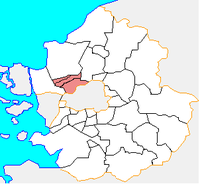
Goyang Geumjeong Cave Massacre
Encyclopedia

Hanja
Hanja is the Korean name for the Chinese characters hanzi. More specifically, it refers to those Chinese characters borrowed from Chinese and incorporated into the Korean language with Korean pronunciation...
: 高陽衿井窟民間人虐殺 Goyang Geunjeong Cave civilian massacre) was a massacre
Massacre
A massacre is an event with a heavy death toll.Massacre may also refer to:-Entertainment:*Massacre , a DC Comics villain*Massacre , a 1932 drama film starring Richard Barthelmess*Massacre, a 1956 Western starring Dane Clark...
conducted by the police officers of Goyang Police Station of the South Korean Police between 9 October 1950 and 31 October 1950 of 150 or 153 unarmed citizens in Goyang
Goyang
Goyang is a city in Gyeonggi Province, South Korea. Goyang includes the new city of Ilsan, which is connected to Seoul via Seoul Subway Line 3. Goyang is bordered by Seoul to the south; walls of the Bukhan Mountain Fortress lie along a small portion of this border.Several institutions of higher...
, Gyeonggi-do
Gyeonggi-do
Gyeonggi-do is the most populous province in South Korea. The provincial capital is located at Suwon. Seoul—South Korea's largest city and national capital—is located in the heart of the province, but has been separately administered as a provincial-level special city since 1946...
district of South Korea
South Korea
The Republic of Korea , , is a sovereign state in East Asia, located on the southern portion of the Korean Peninsula. It is neighbored by the People's Republic of China to the west, Japan to the east, North Korea to the north, and the East China Sea and Republic of China to the south...
. After the victory of the Second Battle of Seoul
Second Battle of Seoul
The Second Battle of Seoul was the battle to recapture Seoul from the North Koreans in late September 1950.The advance on Seoul was slow and bloody, after the landings at Inchon. The NKPA launched a T-34 attack, which was trapped and destroyed, and a Yak bombing run in Incheon harbor, which did...
, South Korean police arrested and killed people and their families who they suspected had been sympathizers during North Korean rule.
In 1995, the 153 victims bodies were excavated by their families. In June
June
June is the sixth month of the year in the Julian and Gregorian calendars and one of the four months with a length of 30 days. Ovid provides two etymologies for June's name in his poem concerning the months entitled the Fasti...
2006, the Truth and Reconciliation Commission
Truth and Reconciliation Commission (South Korea)
South Korea's Truth and Reconciliation Commission , established on December 1, 2005, is a governmental body responsible for investigating incidents in Korean history which occurred starting from Japan's rule of Korea in 1910 up until the end of Authoritarian Rule in Korea with the election of...
demanded that the South Korean government apologize and erect a monument for the victims. However, the government did not show intentions to follow through on the TRCK recommendation. In 2007, Truth and Reconciliation Commission
Truth and Reconciliation Commission (South Korea)
South Korea's Truth and Reconciliation Commission , established on December 1, 2005, is a governmental body responsible for investigating incidents in Korean history which occurred starting from Japan's rule of Korea in 1910 up until the end of Authoritarian Rule in Korea with the election of...
again demanded that the government apologize, provide compensation, and erect a memorial for the victims, however, the government continued to ignore the TRCK recommendation.
On November 28, 2011, the Seoul
Seoul
Seoul , officially the Seoul Special City, is the capital and largest metropolis of South Korea. A megacity with a population of over 10 million, it is the largest city proper in the OECD developed world...
central court ordered the South Korean government to apologize, pay reparations, and found a memorial to the victims' families.
See also
- Truth and Reconciliation Commission (South Korea)Truth and Reconciliation Commission (South Korea)South Korea's Truth and Reconciliation Commission , established on December 1, 2005, is a governmental body responsible for investigating incidents in Korean history which occurred starting from Japan's rule of Korea in 1910 up until the end of Authoritarian Rule in Korea with the election of...
- Bodo League massacreBodo League massacreThe Bodo League massacre was a massacre of alleged communists and suspected sympathizers that occurred in the summer of 1950 during the Korean War. Estimates of the death toll vary. According to Prof. Kim Dong-Choon, Commissioner of the Truth and Reconciliation Commission, at least 100,000 people...
- Jeju Uprising
- Mungyeong massacreMungyeong massacreThe Mungyeong massacre was a massacre conducted by 2nd and 3rdplatoon, 7th company, 3rd battalion, 25th Infantry Regiment, 3rd Infantry Division of the South Korean Army on 24 December 1949 of 86 to 88 unarmed citizens in Mungyeong, North Gyeongsang district of South Korea, all of whom were...
- Geochang massacreGeochang massacreThe Geochang massacre was a massacre conducted by the third battalion of the 9th regiment of the 11th Division of the South Korean Army between 9 February 1951 and 11 February 1951 of 719 unarmed citizens in Geochang, South Gyeongsang district of South Korea. The victims included 385 children. The...
- List of massacres in South Korea
External links
- Truth and Reconciliation Activities of the Past Three Years Truth and Reconciliation Commission, Republic of KoreaTruth and Reconciliation Commission (South Korea)South Korea's Truth and Reconciliation Commission , established on December 1, 2005, is a governmental body responsible for investigating incidents in Korean history which occurred starting from Japan's rule of Korea in 1910 up until the end of Authoritarian Rule in Korea with the election of...
South Korea°N date=Novenber 2011°W

